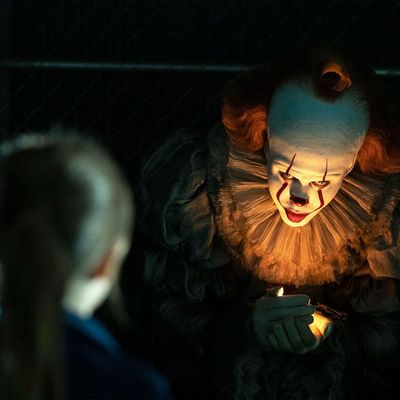
Memory is as much shaped by who we are as who we yearn to be. What we live isn’t so easily catalogued; it mutates, skitters, and fades in the face of the prevailing story we dictate about who we imagine ourselves to be. But what happens when memories long forgotten and inescapable come to the forefront? Who do we become then? It’s this emotional bramble of yearning and personal storytelling that is the engine of director Andy Muschietti’s It Chapter Two.
The film’s focus on memory sometimes works to its advantage, reminding us in plentiful flashbacks that what illuminated and elevated its predecessor was the tender, sparkling chemistry of its young cast. The film draws a distinct line from the hurts of the characters’ younger selves to the wounds they carry as adults 27 years later when the film picks up. They drop their respective lives in order to return to Derry and finish the battle that they started long ago at the urging of a desperate Mike (Isaiah Mustafa), the only member of the Loser’s Club to stay in their hometown, eventually becoming the town librarian who has given his life over to obsession. But each of them is bruised in their own fashion. Ben (Jay Ryan) has shed his weight and become a successful architect still haunted by the bullying of his past. (He carries around a yearbook page as if its signature is the only act of kindness he’s ever received.) Eddie (James Ransone) is a terrifyingly high-strung adult. Bill (James McAvoy) has found success as a novelist but can’t seem to pull off an ending — his introduction on a film set includes a Peter Bogdonavich cameo, of all things — and remains shadowed by the loss of his younger brother, Georgie. Richie (Bill Hader) is a standup comedian and barely functioning alcoholic. Beverly (Jessica Chastain) is in a brutally abusive marriage, revealed in an increasingly uncomfortable scene that is never properly addressed again.
That’s the thing: It Chapter Two moves with an almost too swift purpose, never feeling the weight of its nearly three-hour runtime; although it is long, the film feels frustratingly thin. Meanwhile, the film is aggressively sentimental, and moments of emotional catharsis or terror don’t often hit the way they need to. When they do, it is because of the dedication of the acting.
Most galling in It Chapter Two is its uneven application of horror. (All this despite an unfurling of horror references onscreen, including a sequence that takes a page from The Thing.) The various ghouls that besiege the grown-up Loser’s Club, all visions of Pennywise, are silly, textureless creations. With them, suspense is in short supply. Their scares are more gross than chilling, leaving little impact once they’re out of sight. Perhaps the greatest failure in this regard is how criminally it wastes Pennywise himself, although Bill Skarsgård’s gusto is appreciated. Pennywise flutters in and out of the film with his glowing eyes and drooling maw, fizzling into a palid ending. Ultimately, Muschietti and writer Gary Dauberman can’t make the variety of tones and styles feel cohesive. It Chapter Two swerves from carnival-based horror to fantasy to romance to nostalgia trip and back again, sometimes within the span of a single scene, thickly layering on comedy from Hader that surely delights in some moments but often diffuses the tension the film sorely needs.
The most troublesome example of the film’s tonal confusion is its opening scene, which details a vicious, unflinching hate crime against a gay couple (played by Taylor Frey and actor/director Xavier Dolan) that dovetails into the fantastical when Pennywise’s amber-glowing eyes cut through the darkness. It’s a transition that didn’t sit well with me, especially when it became clear it wouldn’t be unpacked later. By the time the voiceover monologue that bookends the film returns, replete with swelling music to pluck at your heartstrings, the nostalgia feels pockmarked. Part of the problem lies in the fact that the movie separates the cast, led by Hader and Chastain as embodiments of melancholy, for long stretches, forgetting that its best sequences allow the Losers’ Club members to play off one another, hiding their fear with jokes or downturned glances.
Here, no amount of hiding or running away leads any of our characters to fully escape the memories that shape them and make them whole. The grown-up members of the Loser’s Club stumble through the horrors of memory with anxious zeal and sometimes frantic humor, but the film needed to dig deeper. It needed to thread the horror and tension more expertly for such a journey to stay in the mind of the viewer.


